PROBLEMS
WORKING WITH THE FIGURES
Question 1
Using Table 3-1, answer the following questions about probability values:
If χ2 is calculated to be 17 with 9 df, what is the approximate probability value?
If χ2 is 17 with 6 df, what is the probability value?
What trend (“rule”) do you see in the previous two calculations?
Question 2
Inspect Figure 3-8: which meiotic stage is responsible for generating Mendel’s second law?
Question 3
In Figure 3-9,
identify the diploid nuclei.
identify which part of the figure illustrates Mendel’s first law.
Question 4
Inspect Figure 3-10: what would be the outcome in the octad if on rare occasions a nucleus from the postmeiotic mitotic division of nucleus 2 slipped past a nucleus from the postmeiotic mitotic division of nucleus 3? How could you measure the frequency of such a rare event?
Question 5
In Figure 3-11, if the input genotypes were a · B and A · b, what would be the genotypes colored blue?
Question 6
In the progeny seen in Figure 3-13, what are the origins of the chromosomes colored dark blue, light blue, and very light blue?
Question 7
In Figure 3-17, in which bar of the histogram would the genotype R1/r1 · R2/R2 · r3/r3 be found?
Question 8
In examining Figure 3-19, what do you think is the main reason for the difference in size of yeast and human mtDNA?
Question 9
In Figure 3-20, what color is used to denote cytoplasm containing wild-
Question 10
In Figure 3-21, what would be the leaf types of progeny of the apical (top) flower?
Question 11
From the pedigree in Figure 3-25, what principle can you deduce about the inheritance of mitochondrial disease from affected fathers?
BASIC PROBLEMS
Question 12
Assume independent assortment and start with a plant that is dihybrid A/a; B/b:
What phenotypic ratio is produced from selfing it?
What genotypic ratio is produced from selfing it?
What phenotypic ratio is produced from testcrossing it?
What genotypic ratio is produced from testcrossing it?
Question 13
Normal mitosis takes place in a diploid cell of genotype A/a; B/b. Which of the following genotypes might represent possible daughter cells?
A; B
a; b
A; b
a; B
A/A; B/B
A/a; B/b
a/a; b/b
Question 14
In a diploid organism of 2n = 10, assume that you can label all the centromeres derived from its female parent and all the centromeres derived from its male parent. When this organism produces gametes, how many male-
Question 15
It has been shown that when a thin beam of light is aimed at a nucleus, the amount of light absorbed is proportional to the cell’s DNA content. Using this method, the DNA in the nuclei of several different types of cells in a corn plant were compared. The following numbers represent the relative amounts of DNA in these different types of cells:
0.7, 1.4, 2.1, 2.8, and 4.2
Which cells could have been used for these measurements? (Note: In plants, the endosperm part of the seed is often triploid, 3n.)
Question 16
Draw a haploid mitosis of the genotype a+; b.
Question 17
In moss, the genes A and B are expressed only in the ga-
What proportion of the gametophytes will be A; B?
If fertilization is random, what proportion of sporo-
phytes in the next generation will be A/a; B/b?
Question 18
When a cell of genotype A/a; B/b; C/c having all the genes on separate chromosome pairs divides mitotically, what are the genotypes of the daughter cells?
Question 19
In the haploid yeast Saccharomyces cerevisiae, the two mating types are known as MATa and MATα. You cross a purple (ad–) strain of mating type a and a white (ad+) strain of mating type α. If ad– and ad+ are alleles of one gene, and a and α are alleles of an independently inherited gene on a separate chromosome pair, what progeny do you expect to obtain? In what proportions?
Question 20
In mice, dwarfism is caused by an X-
Question 21
Suppose you discover two interesting rare cytological abnormalities in the karyotype of a human male. (A karyotype is the total visible chromosome complement.) There is an extra piece (satellite) on one of the chromosomes of pair 4, and there is an abnormal pattern of staining on one of the chromosomes of pair 7. With the assumption that all the gametes of this male are equally viable, what proportion of his children will have the same karyotype that he has?
Question 22
Suppose that meiosis occurs in the transient diploid stage of the cycle of a haploid organism of chromosome number n. What is the probability that an individual haploid cell resulting from the meiotic division will have a complete parental set of centromeres (that is, a set all from one parent or all from the other parent)?
Question 23
Pretend that the year is 1868. You are a skilled young lens maker working in Vienna. With your superior new lenses, you have just built a microscope that has better resolution than any others available. In your testing of this microscope, you have been observing the cells in the testes of grasshoppers and have been fascinated by the behavior of strange elongated structures that you have seen within the dividing cells. One day, in the library, you read a recent journal paper by G. Mendel on hypothetical “factors” that he claims explain the results of certain crosses in peas. In a flash of revelation, you are struck by the parallels between your grasshopper studies and Mendel’s pea studies, and you resolve to write him a letter. What do you write? (Problem 23 is based on an idea by Ernest Kroeker.)
Question 24
From a presumed testcross A/a × a/a, in which A represents red and a represents white, use the χ2 test to find out which of the following possible results would fit the expectations:
120 red, 100 white
5000 red, 5400 white
500 red, 540 white
50 red, 54 white
Question 25
Look at the Punnett square in Figure 3-4.
How many different genotypes are shown in the 16 squares of the grid?
What is the genotypic ratio underlying the 9:3:3:1 phenotypic ratio?
Can you devise a simple formula for the calculation of the number of progeny genotypes in dihybrid, trihybrid, and so forth crosses? Repeat for phenotypes.
Mendel predicted that, within all but one of the phenotypic classes in the Punnett square, there should be several different genotypes. In particular, he performed many crosses to identify the underlying genotypes of the round, yellow phenotype. Show two different ways that could be used to identify the various genotypes underlying the round, yellow phenotype. (Remember, all the round, yellow peas look identical.)
Question 26
Assuming independent assortment of all genes, develop formulas that show the number of phenotypic classes and the number of genotypic classes from selfing a plant heterozygous for n gene pairs.
Question 27
Note: The first part of this problem was introduced in Chapter 2. The line of logic is extended here.
In the plant Arabidopsis thaliana, a geneticist is interested in the development of trichomes (small projections) on the leaves. A large screen turns up two mutant plants (A and B) that have no trichomes, and these mutants seem to be potentially useful in studying trichome development. (If they are determined by single-
F2 from mutant A: 602 normal; 198 no trichomes
F2 from mutant B: 267 normal; 93 no trichomes
What do these results show? Include proposed genotypes of all plants in your answer.
Assume that the genes are located on separate chromosomes. An F1 is produced by crossing the original mutant A with the original mutant B. This F1 is testcrossed: What proportion of testcross progeny will have no trichomes?
Question 28
In dogs, dark coat color is dominant over albino, and short hair is dominant over long hair. Assume that these effects are caused by two independently assorting genes. Seven crosses were done as shown below, in which D and A stand for the dark and albino phenotypes, respectively, and S and L stand for the short-
|
Parental phenotypes |
Number of progeny |
|||
|---|---|---|---|---|
|
D, S |
D, L |
A, S |
A, L |
|
|
a. D, S × D, S |
88 |
31 |
29 |
12 |
|
b. D, S × D, L |
19 |
18 |
0 |
0 |
|
c. D, S × A, S |
21 |
0 |
20 |
0 |
|
d. A, S × A, S |
0 |
0 |
29 |
9 |
|
e. D, L × D, L |
0 |
31 |
0 |
11 |
|
f. D, S × D, S |
45 |
16 |
0 |
0 |
|
g. D, S × D, L |
31 |
30 |
10 |
10 |
Write the genotypes of the parents in each cross. Use the symbols C and c for the dark and albino coat-
Question 29
In tomatoes, one gene determines whether the plant has purple (P) or green (G) stems, and a separate, independent gene determines whether the leaves are “cut” (C) or “potato” (Po). Five matings of tomato-
|
Mating |
Parental phenotypes |
Number of progeny |
|||
|---|---|---|---|---|---|
|
P, C |
P, Po |
G, C |
G, Po |
||
|
1 |
P, C × G, C |
323 |
102 |
309 |
106 |
|
2 |
P, C × P, Po |
220 |
206 |
65 |
72 |
|
3 |
P, C × G, C |
723 |
229 |
0 |
0 |
|
4 |
P, C × G, Po |
405 |
0 |
389 |
0 |
|
5 |
P, Po × G, C |
71 |
90 |
85 |
78 |
Which alleles are dominant?
What are the most probable genotypes for the parents in each cross?
Question 30
A mutant allele in mice causes a bent tail. Six pairs of mice were crossed. Their phenotypes and those of their progeny are given in the following table. N is normal phenotype; B is bent phenotype. Deduce the mode of inheritance of bent tail.
|
Cross |
Parents |
Progeny |
|||
|---|---|---|---|---|---|
|
♀ |
♂ |
♀ |
♂ |
||
|
1 |
|
N |
B |
All B |
All N |
|
2 |
|
B |
N |
½B, ½N |
½B, ½N |
|
3 |
|
B |
N |
All B |
All B |
|
4 |
|
N |
N |
All N |
All N |
|
5 |
|
B |
B |
All B |
All B |
|
6 |
|
B |
B |
All B |
½B, ½N |
Is it recessive or dominant?
Is it autosomal or sex-
linked? What are the genotypes of all parents and progeny?
Question 31
The normal eye color of Drosophila is red, but strains in which all flies have brown eyes are available. Similarly, wings are normally long, but there are strains with short wings. A female from a pure line with brown eyes and short wings is crossed with a male from a normal pure line. The F1 consists of normal females and short-
- ⅜ red eyes, long wings
- ⅜ red eyes, short wings
- ⅛ brown eyes, long wings
- ⅛ brown eyes, short wings
Deduce the inheritance of these phenotypes; use clearly defined genetic symbols of your own invention. State the genotypes of all three generations and the genotypic proportions of the F1 and F2.
 Unpacking Problem 31
Unpacking Problem 31
Before attempting a solution to this problem, try answering the following questions:
What does the word normal mean in this problem?
The words line and strain are used in this problem. What do they mean, and are they interchangeable?
Draw a simple sketch of the two parental flies showing their eyes, wings, and sexual differences.
How many different characters are there in this problem?
How many phenotypes are there in this problem, and which phenotypes go with which characters?
What is the full phenotype of the F1 females called “normal”?
What is the full phenotype of the F1 males called “short winged”?
List the F2 phenotypic ratios for each character that you came up with in answer to question 4.
What do the F2 phenotypic ratios tell you?
What major inheritance pattern distinguishes sex-
linked inheritance from autosomal inheritance? Do the F2 data show such a distinguishing criterion?
Do the F1 data show such a distinguishing criterion?
What can you learn about dominance in the F1? The F2?
What rules about wild-
type symbolism can you use in deciding which allelic symbols to invent for these crosses? What does “deduce the inheritance of these pheno-
types” mean?
Now try to solve the problem. If you are unable to do so, make a list of questions about the things that you do not understand. Inspect the learning goals at the beginning of the chapter and ask yourself which are relevant to your questions. If this approach doesn’t work, inspect the Key Concepts of this chapter and ask yourself which might be relevant to your questions.
Question 32
In a natural population of annual plants, a single plant is found that is sickly looking and has yellowish leaves. The plant is dug up and brought back to the laboratory. Photosynthesis rates are found to be very low. Pollen from a normal dark-
Propose a genetic explanation for the inheritance pattern.
Suggest a simple test for your model.
Account for the reduced photosynthesis, sickliness, and yellowish appearance.
Question 33
What is the basis for the green-

what progeny types can be predicted? What about the reciprocal cross?
Question 34
In Neurospora, the mutant stp exhibits erratic stop-
Question 35
Two corn plants are studied. One is resistant (R) and the other is susceptible (S) to a certain pathogenic fungus. The following crosses are made, with the results shown:

What can you conclude about the location of the genetic determinants of R and S?
Question 36
A presumed dihybrid in Drosophila, B/b; F/f, is test-

Use the χ2 test to determine if these results fit the results expected from testcrossing the hypothesized dihybrid.
Question 37
Are the following progeny numbers consistent with the results expected from selfing a plant presumed to be a dihybrid of two independently assorting genes, H/h; R/r? (H = hairy leaves; h = smooth leaves; R = round ovary; r = elongated ovary.) Explain your answer.

Question 38
A dark female moth is crossed with a dark male. All the male progeny are dark, but half the female progeny are light and the rest are dark. Propose an explanation for this pattern of inheritance.
Question 39
In Neurospora, a mutant strain called stopper (stp) arose spontaneously. Stopper showed erratic “stop and start” growth, compared with the uninterrupted growth of wild-

What do these results suggest regarding the location of the stopper mutation in the genome?
According to your model for part a, what progeny and proportions are predicted in octads from the following cross, including a mutation nic3 located on chromosome VI?

Question 40
In polygenic systems, how many phenotypic classes corresponding to number of polygene “doses” are expected in selfs
of strains with four heterozygous polygenes?
of strains with six heterozygous polygenes?
Question 41
In the self of a polygenic trihybrid R1/r1; R2/r2; R3/r3, use the product and sum rules to calculate the proportion of progeny with just one polygene “dose.”
Question 42
Reciprocal crosses and selfs were performed between the two moss species Funaria mediterranea and F. hygrometrica. The sporophytes and the leaves of the gametophytes are shown in the accompanying diagram.
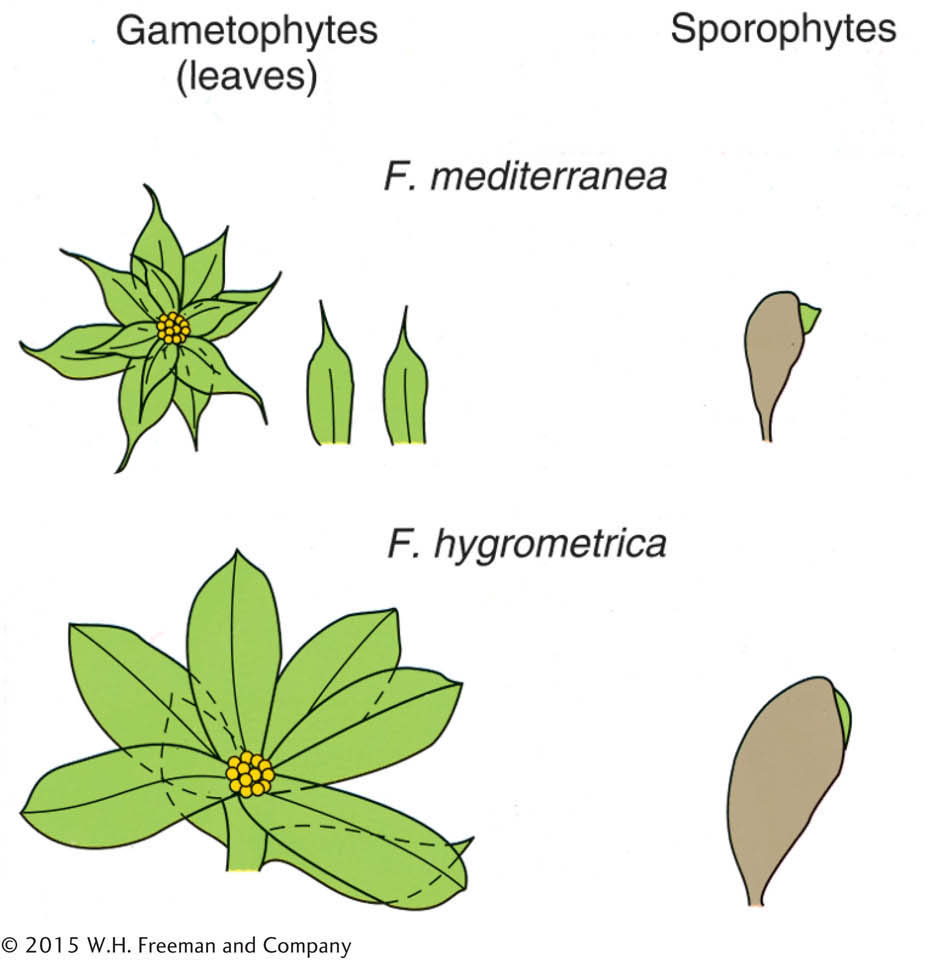
The crosses are written with the female parent first.
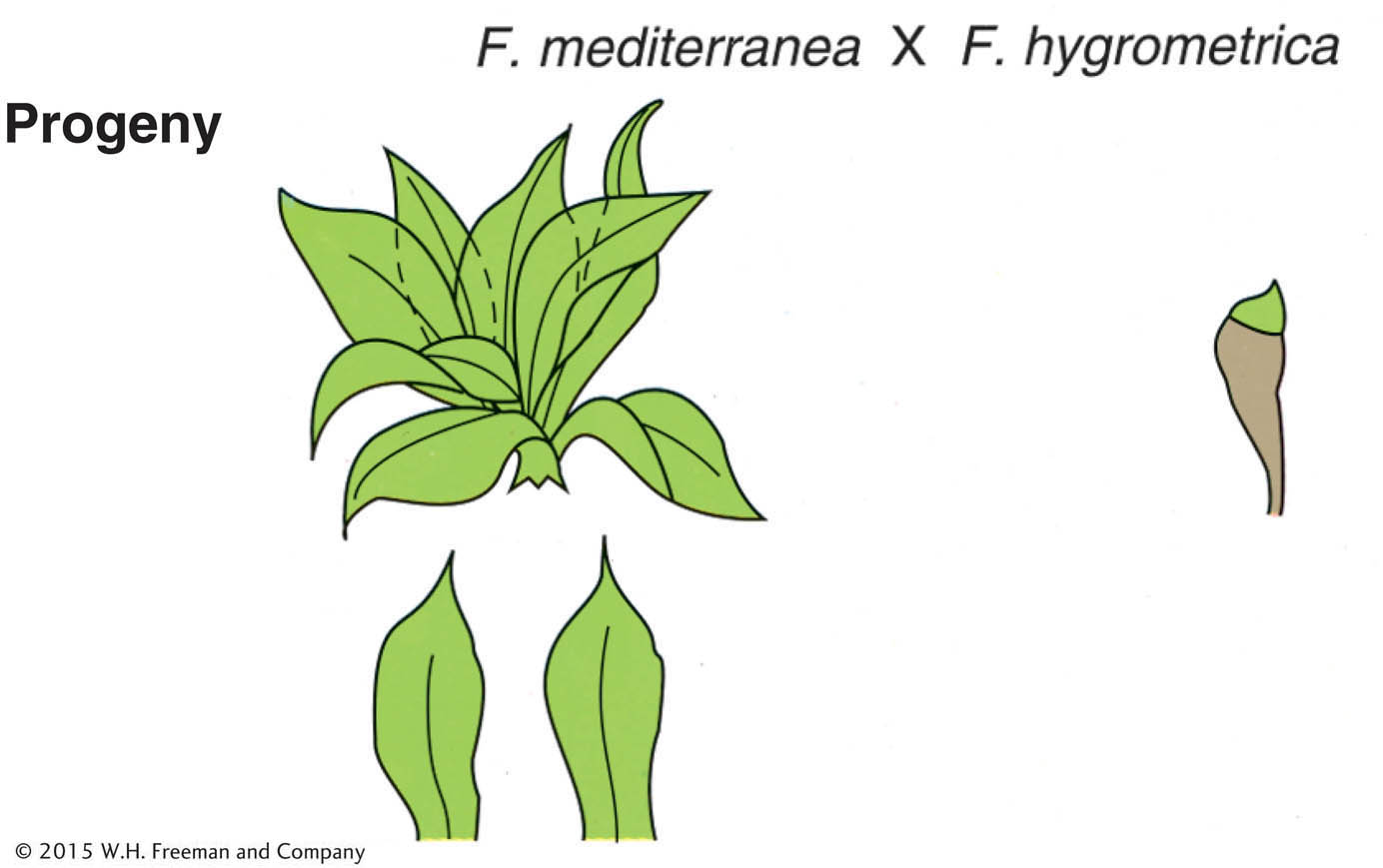
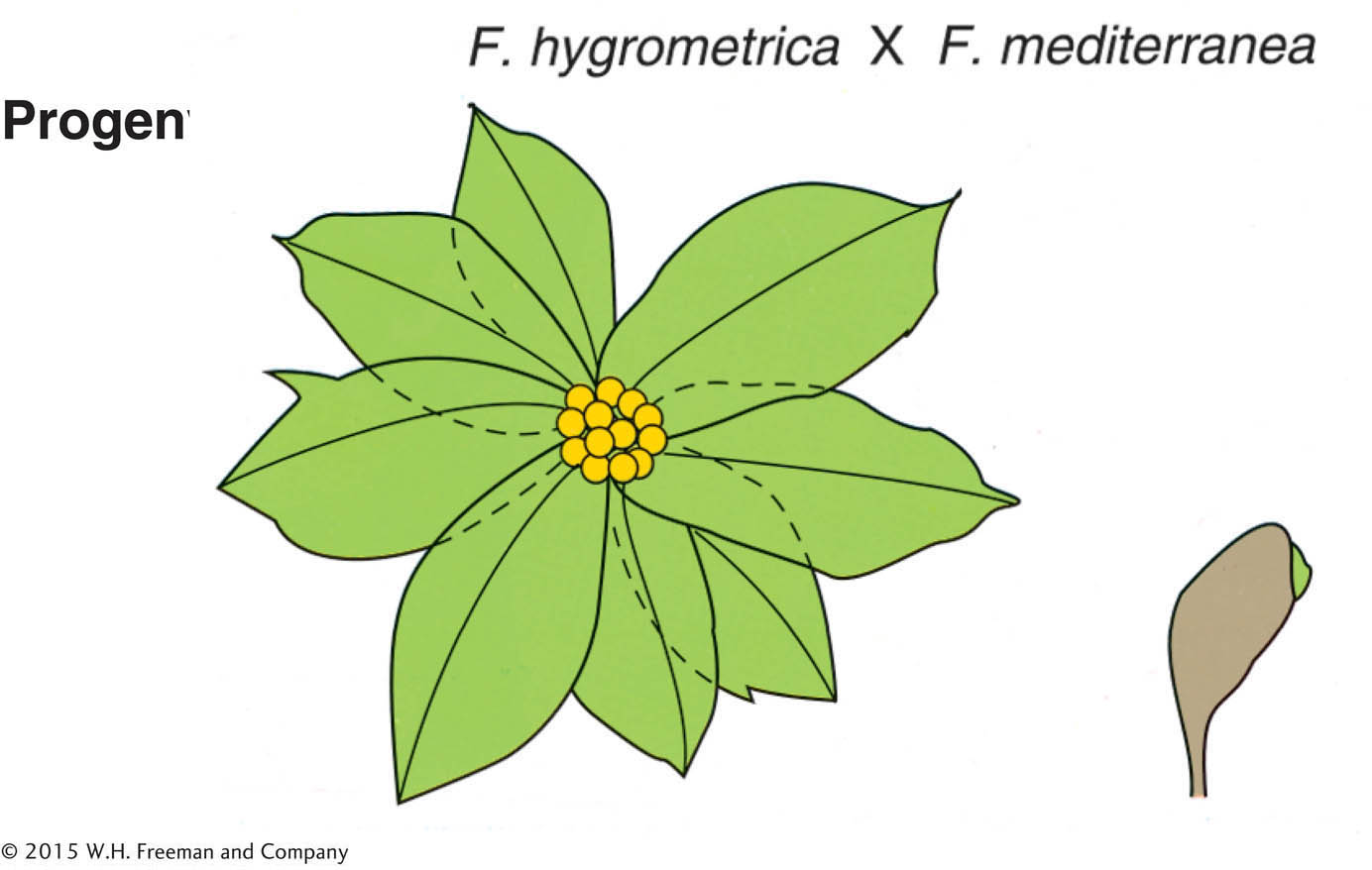
Describe the results presented, summarizing the main findings.
Propose an explanation of the results.
Show how you would test your explanation; be sure to show how it could be distinguished from other explanations.
Question 43
Assume that diploid plant A has a cytoplasm genetically different from that of plant B. To study nuclear-
Question 44
You are studying a plant with tissue comprising both green and white sectors. You wish to decide whether this phenomenon is due (1) to a chloroplast mutation of the type considered in this chapter or (2) to a dominant nuclear mutation that inhibits chlorophyll production and is present only in certain tissue layers of the plant as a mosaic. Outline the experimental approach that you would use to resolve this problem.
CHALLENGING PROBLEMS
Question 45
You have three jars containing marbles, as follows:
|
jar 1 |
600 red |
and |
400 white |
|
jar 2 |
900 blue |
and |
100 white |
|
jar 3 |
10 green |
and |
990 white |
If you blindly select one marble from each jar, calculate the probability of obtaining
a red, a blue, and a green.
three whites.
a red, a green, and a white.
a red and two whites.
a color and two whites.
at least one white.
In a certain plant, R = red and r = white. You self a red R/r heterozygote with the express purpose of obtaining a white plant for an experiment. What minimum number of seeds do you have to grow to be at least 95 percent certain of obtaining at least one white individual?
When a woman is injected with an egg fertilized in vitro, the probability of its implanting successfully is 20 percent. If a woman is injected with five eggs simultaneously, what is the probability that she will become pregnant? (Part c is from Margaret Holm.)
Question 46
In tomatoes, red fruit is dominant over yellow, two-
Question 47
We have dealt mainly with only two genes, but the same principles hold for more than two genes. Consider the following cross:
A/a; B/b; C/c; D/d; E/e χ a/a; B/b; c/c; D/d; e/e
What proportion of progeny will phenotypically resemble (1) the first parent, (2) the second parent, (3) either parent, and (4) neither parent?
What proportion of progeny will be genotypically the same as (1) the first parent, (2) the second parent, (3) either parent, and (4) neither parent?
Assume independent assortment.
Question 48
The accompanying pedigree shows the pattern of transmission of two rare human phenotypes: cataract and pituitary dwarfism. Family members with cataract are shown with a solid left half of the symbol; those with pituitary dwarfism are indicated by a solid right half.
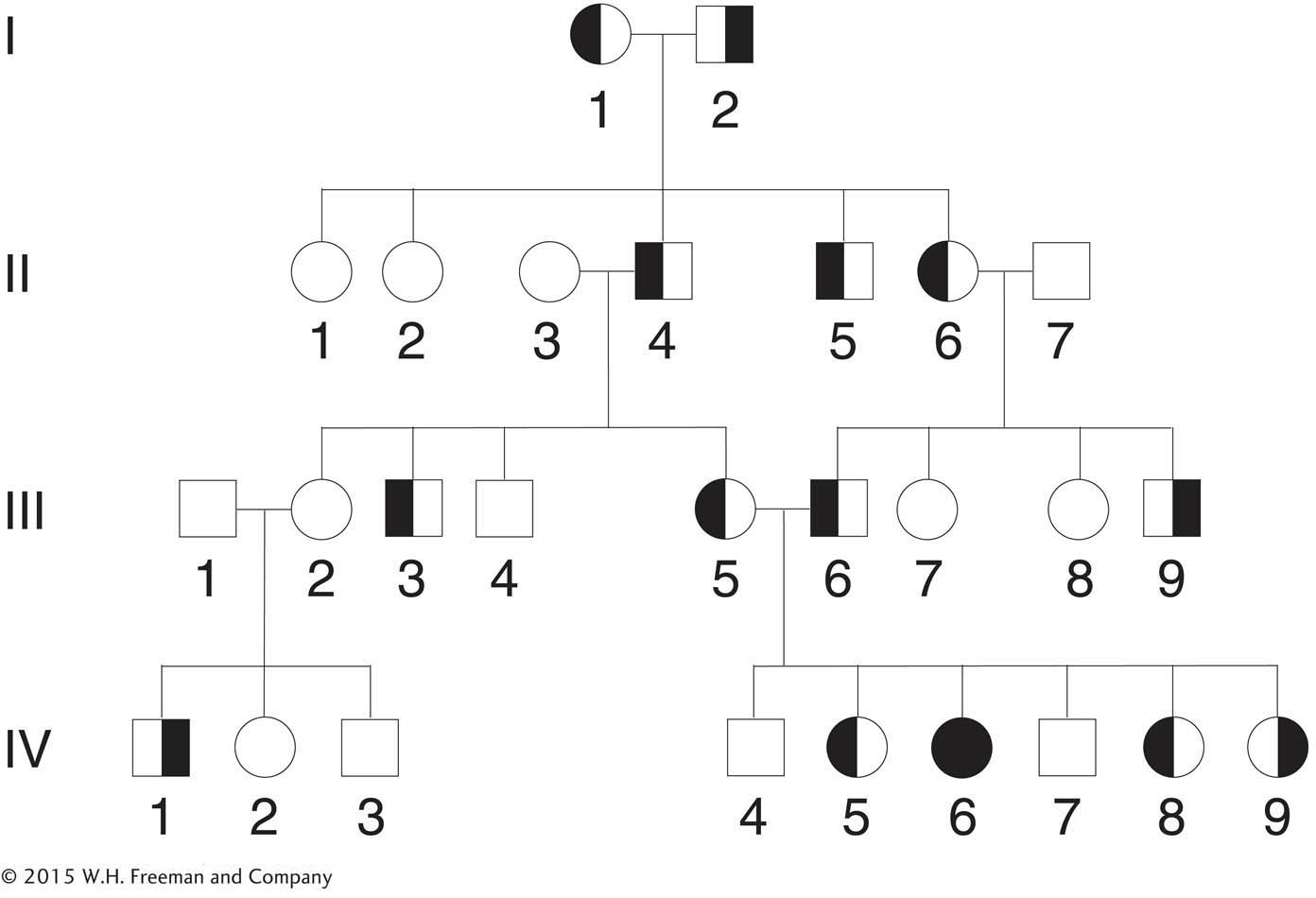
What is the most likely mode of inheritance of each of these phenotypes? Explain.
List the genotypes of all members in generation III as far as possible.
If a hypothetical mating took place between IV-
1 and IV- 5, what is the probability of the first child’s being a dwarf with cataracts? A phenotypically normal child? (Problem 48 is adapted from J. Kuspira and R. Bhambhani, Compendium of Problems in Genetics. Copyright 1994 by Wm. C. Brown.)
Question 49
A corn geneticist has three pure lines of genotypes a/a; B/B; C/C, A/A; b/b; C/C, and A/A; B/B; c/c. All the phenotypes determined by a, b, and c will increase the market value of the corn; so, naturally, he wants to combine them all in one pure line of genotype a/a; b/b; c/c.
Outline an effective crossing program that can be used to obtain the a/a; b/b; c/c pure line.
At each stage, state exactly which phenotypes will be selected and give their expected frequencies.
Is there more than one way to obtain the desired genotype? Which is the best way?
Assume independent assortment of the three gene pairs. (Note: Corn will self or cross-
Question 50
In humans, color vision depends on genes encoding three pigments. The R (red pigment) and G (green pigment) genes are close together on the X chromosome, whereas the B (blue pigment) gene is autosomal. A recessive mutation in any one of these genes can cause color blindness. Suppose that a color-
Question 51
Consider the accompanying pedigree for a rare human muscle disease.

What unusual feature distinguishes this pedigree from those studied earlier in this chapter?
Where do you think the mutant DNA responsible for this phenotype resides in the cell?
Question 52
The plant Haplopappus gracilis has a 2n of 4. A diploid cell culture was established and, at premitotic S phase, a radioactive nucleotide was added and was incorporated into newly synthesized DNA. The cells were then removed from the radioactivity, washed, and allowed to proceed through mitosis. Radioactive chromosomes or chro-
Question 53
In the species of Problem 52, you can introduce radioactivity by injection into the anthers at the S phase before meiosis. Draw the four products of meiosis with their chromosomes, and show which are radioactive.
Question 54
The plant Haplopappus gracilis is diploid and 2n = 4. There are one long pair and one short pair of chromosomes. The diagrams below (numbered 1 through 12) represent anaphases (“pulling apart” stages) of individual cells in meiosis or mitosis in a plant that is genetically a dihybrid (A/a; B/b ) for genes on different chromosomes. The lines represent chromosomes or chromatids, and the points of the V’s represent centromeres. In each case, indicate if the diagram represents a cell in meiosis I, meiosis II, or mitosis. If a diagram shows an impossible situation, say so.
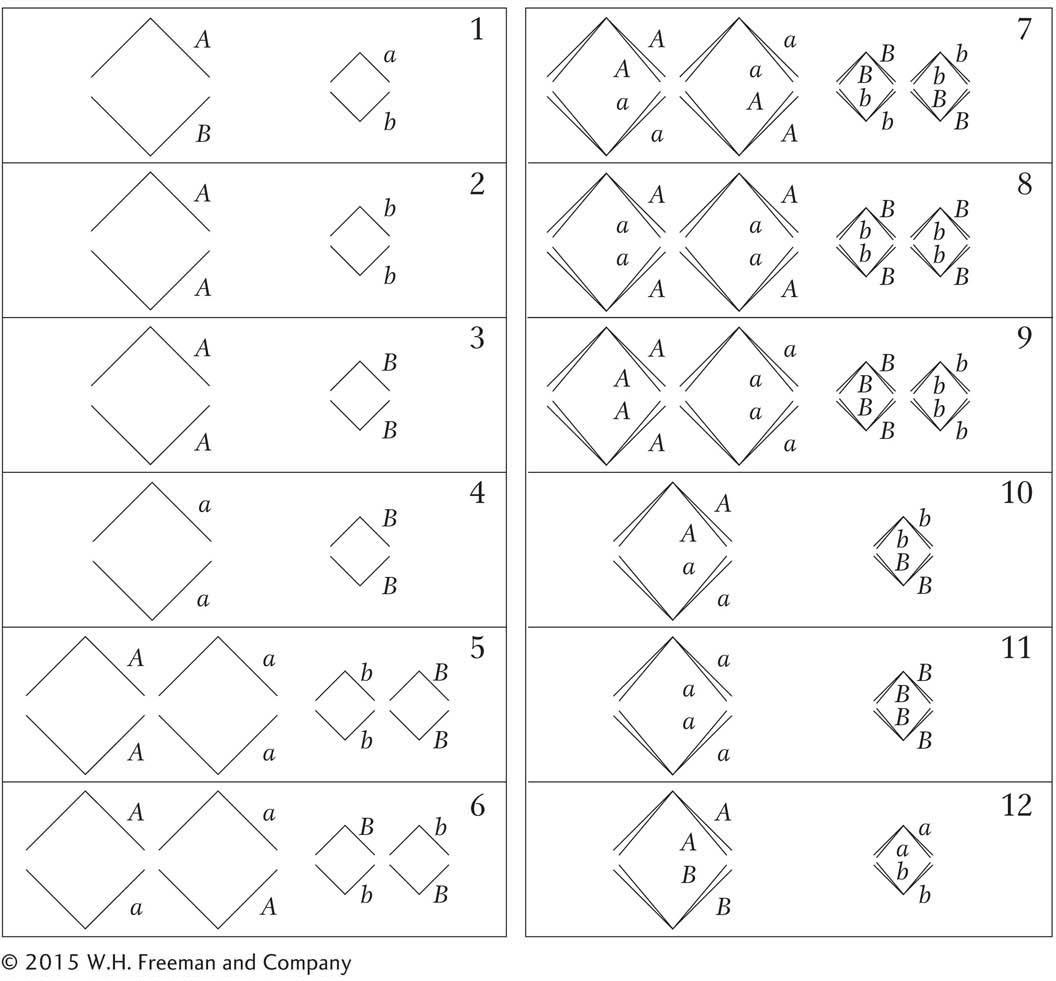
Question 55
The pedigree below shows the recurrence of a rare neurological disease (large black symbols) and spontaneous fetal abortion (small black symbols) in one family. (A slash means that the individual is deceased.) Provide an explanation for this pedigree in regard to the cytoplasmic segregation of defective mitochondria.

Question 56
A man is brachydactylous (very short fingers; rare autosomal dominant), and his wife is not. Both can taste the chemical phenylthiocarbamide (autosomal dominant; common allele), but their mothers could not.
Give the genotypes of the couple.
If the genes assort independently and the couple has four children, what is the probability of
all of them being brachydactylous?
none being brachydactylous?
all of them being tasters?
all of them being nontasters?
all of them being brachydactylous tasters?
none being brachydactylous tasters?
at least one being a brachydactylous taster?
Question 57
One form of male sterility in corn is maternally transmitted. Plants of a male-
Research shows that the introduction of restorer alleles into male-
sterile lines does not alter or affect the maintenance of the cytoplasmic factors for male sterility. What kind of research results would lead to such a conclusion? A male-
sterile plant is crossed with pollen from a plant homozygous for Rf. What is the genotype of the F1? The phenotype? The F1 plants from part b are used as females in a testcross with pollen from a normal plant (rf/rf). What are the results of this testcross? Give genotypes and phenotypes, and designate the kind of cytoplasm.
The restorer allele already described can be called Rf-
1 . Another dominant restorer, Rf-2 , has been found. Rf-1 and Rf-2 are located on different chromosomes. Either or both of the restorer alleles will give pollen fertility. With the use of a male-sterile plant as a tester, what will be the result of a cross in which the male parent is heterozygous at both restorer loci?
homozygous dominant at one restorer locus and homozygous recessive at the other?
heterozygous at one restorer locus and homozygous recessive at the other?
heterozygous at one restorer locus and homozygous dominant at the other?